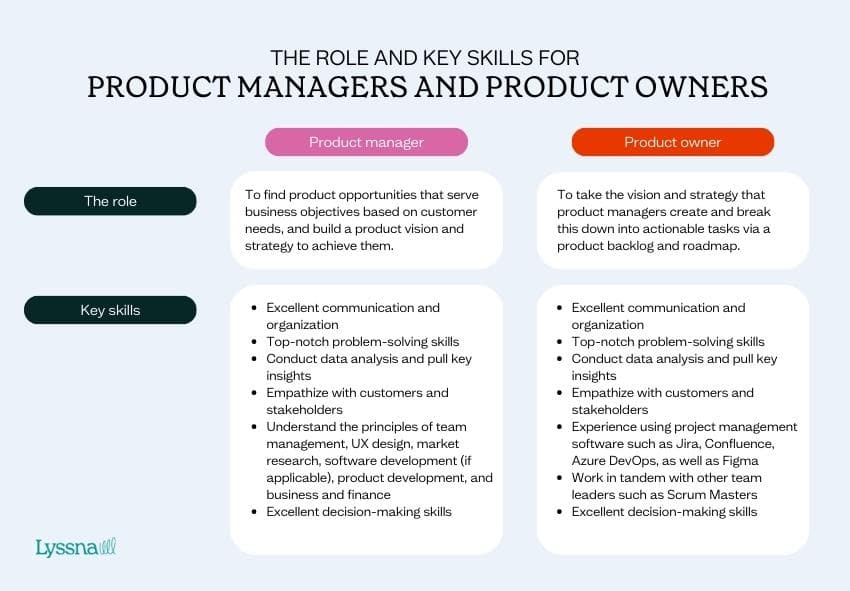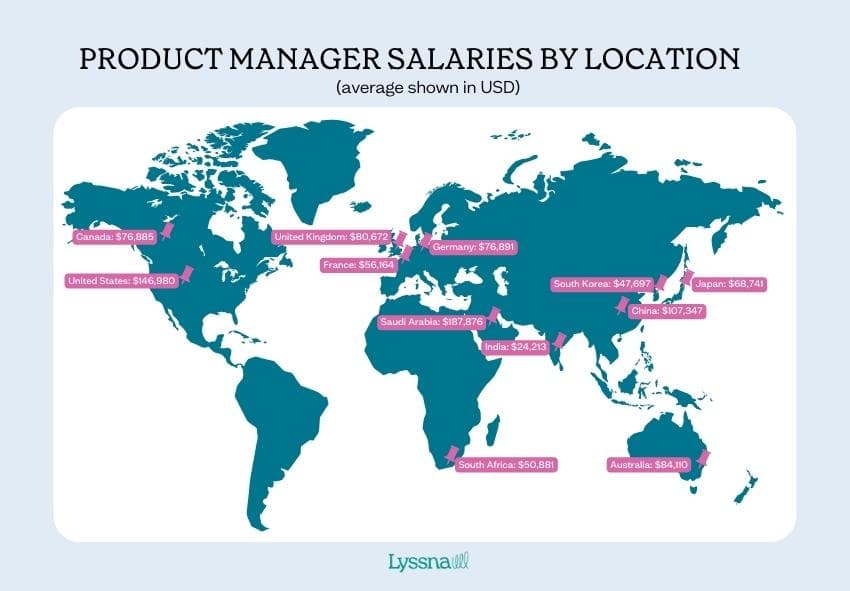14 Nov 2025
|8 min
Product owner vs product manager
Unsure about pursuing a product manager or product owner role? Get insights on role differences, responsibilities, skills, and salaries to make an informed choice.

Chances are you clicked on this link for one of two reasons. Maybe you’ve got some knowledge of user experience and you’re interested in a more challenging role, but you’re unsure whether to go for a product manager or product owner position.
Or maybe you’re in a product development team or you’re a hiring manager looking to understand the differences between these two roles.
Either way, you’re in luck. This guide will walk you through the following topics:
What is a product manager?
What is a product owner?
Key differences and similarities
Product manager vs product owner: Responsibilities, skills, and salaries
How product managers and product owners work together
Understanding these points will help you to make a more informed career choice or better understand the makeup of your product team.
What is a product manager?
We won’t go into too much detail on the product manager role here since we've already covered it in a comprehensive guide: What does a product manager do?
But in summary, product managers are key decision-makers for all things product. They identify customer needs, determine business objectives that a product addressing those needs could meet, and build the product vision and product strategy.
Product managers are responsible for the long-term vision of the product, so it’s a deeply strategic role. Though, as you’ll see in the key differences and similarities section, there are other tasks product managers are responsible for, too.
In the video below, Maureen, Senior Product Manager at Lyssna, shares how she got into product management
What is a product owner?
Similar to the above, we’ve already published a guide covering the product owner role in detail, which you can find here: What is a product owner?
But to catch you up, the role of a product owner is critical in a product development team, particularly those that use the agile framework and scrum framework methodologies. Whether or not a product owner is part of an agile team or a scrum team, they have their two important tasks: executing the product roadmap and managing the product backlog.
Product owners are the people team members go to for actionable tasks and project management during the product development process.
Your go-to user research platform
The best teams use Lyssna so they can deeply understand their audience and move in the right direction — faster.
Key similarities and differences between product managers and product owners
Here’s a summary of the key similarities and differences between product owners and product managers.
Comparison | Product manager | Product owner |
|---|---|---|
Definition | • The role of the product manager is to find product opportunities that serve business objectives based on customer needs, and build a product vision and strategy to achieve them. | • The role of the product owner is to take the vision and strategy that product managers create and break this down into actionable tasks via a product backlog and roadmap. |
Goals | • To create products that serve the needs and goals of customers and to represent the voice of the customer to senior management. | • To create products that serve the needs and goals of customers and to represent the voice of the customer to senior management. |
Methods and tools | • Outward-focused market research • Customer interviews • User surveys • Focus groups • Usability testing software • Writing user personas • Communicating closely with various stakeholders • Determining product success metrics | • Project management software • Usability testing software • Writing user stories • Managing the live team backlog document • The Scrum Guide™ • Scrum events, e.g. sprints and retrospectives |
Role in the development process | • The bulk of a product manager’s role happens before and at the start of product development (e.g. market research and vision building) and toward the end of a product lifecycle (e.g. tracking success, looking for improvements). | • The bulk of a product owner’s role happens during product development (e.g. backlog and task management). But they also have to work out the product roadmap in the beginning and manage this until the product launch. |
Key skills | • Excellent communication and organization, particularly with experience in managing cross-functional teams • Top-notch problem-solving skills • Being able to conduct data analysis and pull key insights • Being able to empathize with customers and stakeholders • Understanding the principles of team management/leadership, UX design, market research, software development (if applicable), product development, and business and finance • Excellent decision-making skills | • Excellent communication and organization • Top-notch problem-solving skills • Being able to conduct data analysis and pull key insights • Being able to empathize with customers and stakeholders • Experience using project management software such as Jira, - Confluence, Azure DevOps, as well as Figma (for prototype testing) • Working in tandem with other team leaders such as Scrum Masters • Excellent decision-making skills |
Training/education required | • Many product manager roles don’t require formal education or training. Instead, they ask for previous experience. | • Often, product owner roles ask for both related experience and higher education degrees. The main difference is the broader spectrum of experience a potential product owner can lean on to get this role. |
Average salary (US) | $146,980 | $125,809 |
These are the fundamental differences and similarities between these two roles. If you’re interested in a little more detail, read on.
Product owner vs product manager: Responsibilities, skills, and salaries
As you can see from the summary table above, there are some similarities between the roles – you can consider both to be product leaders who work with multiple people to make a great product. However, there are also a few key differences – namely, what type of tasks they prioritize on a day-to-day basis. Let’s take a deeper look at these.

Responsibilities of a product manager vs product owner
There are five key areas product managers handle during the product development process:
Finding product opportunities
Defining product vision
Building product strategy
Aligning stakeholders
Building a knowledge base
Each of these responsibilities translates into several tasks a product manager might do during their day-to-day work. However, depending on the needs of the business, product owners might have five to eight different responsibilities, including:
Communicating the product vision
Managing the product backlog
Participating in scrum events (if applicable)
Prioritizing the needs of stakeholders
Being a key point of contact
Understanding the market and consumer needs
As you can see, most product management work is high level. In comparison, a product owner's work usually involves measurable actions and clear milestones.
Skills of product managers vs product owners
We already showed the skills required for each role in the summary table. But to expand slightly, for both positions, it’s also helpful to have industry-specific knowledge to serve the target audience of your product better. If you come from another industry, chances are the product strategies will be different from the one you’ve experienced before.
Another skill product managers should also cultivate is presenting to and collaborating with senior/leadership roles. First, to pitch product opportunities. Second, to communicate everything the product development team has worked on to the go-to-market team ready for a successful launch.
Finally, another skill both product managers and product owners should improve over time is the ability to learn. You should never underestimate the skill of learning – for both roles, it can help you develop other skills with far greater efficiency and effectiveness.
Salaries of product managers and product owners
On average, and at the time of writing, product managers and product owners earn US $146,980 and $125,809 respectively. This difference in salary is likely due to seniority (product managers often report to executives, for example, while product owners often report to the product manager).
How do salaries compare in other countries around the world? Let’s take a look:

Product manager
Canada: CA$103,906 (Glassdoor)
United Kingdom: £63,703 (Glassdoor)
Australia: A$130,000 (Glassdoor)
South Africa: ZAR 960,000 (Glassdoor)
China: CN¥780,000 (Glassdoor)
India: ₹2M (Glassdoor)
Germany: €71,000 (Glassdoor)
France: €51,800 (Glassdoor)
Saudi Arabia: SAR 704,712 (Glassdoor)
South Korea: ₩63M (Glassdoor)
Japan: JP¥10M (Glassdoor)

Product owner:
Canada: CA$99,021 (Glassdoor)
United Kingdom: £60,491 (Glassdoor)
Australia: A$140,250 (Glassdoor)
South Africa: ZAR 978,036 (Glassdoor)
China: CN¥1,635,216 (Glassdoor)
India: ₹2M (Glassdoor)
Germany: €76,950 (Glassdoor)
France: €49,000 (Glassdoor)
Saudi Arabia: SAR 994,944 (Glassdoor)
South Korea: ₩97M (Glassdoor)
Japan: JP¥11M (Glassdoor)
Interestingly, some countries appear to pay product owners more than product managers – this is likely due to cultural differences in each role’s responsibilities.
How product managers and product owners work together
In the US, at least, product managers and product owners work in tandem with each other. The manager creates the product vision while the product owner translates that vision into actionable chunks (like separate feature backlog requests). The product owner then delegates these tasks to appropriate team members.
During the product development process, the product owner reports to the product manager about the team’s progress, including details about sprints, milestones achieved and what’s to come, and any insights from usability testing.
From there, the product manager may decide to make changes based on the feedback and new knowledge, repeating the cycle for each product development iteration.
Product manager or product owner? You decide.
Now that you know more about each role, you should have a better understanding of which one you might like to pursue (or which one you need to hire).
Remember, it’s not always about the salary – even though one role might have a higher salary (depending on your location), your skills, experience, and work preferences may have you leaning toward one role over another.
If you’re itching to learn more, check out our other product management guides.
Or better yet, learn the tools of the trade by actually using them. Lyssna is a remote user testing platform that takes the guesswork out of product and design decisions via user interviews and usability testing.
Elevate your research practice
Join over 320,000+ marketers, designers, researchers, and product leaders who use Lyssna to make data-driven decisions.

Alexander Boswell
Technical writer
Alexander Boswell is a product-led content writer and researcher with a background in marketing strategy and consumer behaviour. When he’s not writing, he’s playing baseball and D&D.
You may also like
Stay in the loop by signing up for our newsletter
We'll keep you updated with the latest tools & insights to elevate your research game.





